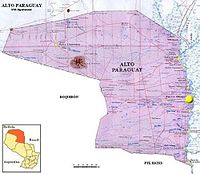La Victoria District, Paraguay
| La Victoria | |
|---|---|
 |
|
| Coordinates: 22°17′24″S 57°56′24″W / 22.29000°S 57.94000°WCoordinates: 22°17′24″S 57°56′24″W / 22.29000°S 57.94000°W | |
| Country | Paraguay |
| Department | Alto Paraguay |
| Founded | 1889, Carlos Casado |
| Government | |
| • Intendente Municipal | Raúl Benicio Lagraña Cuello |
| Elevation | 64 m (210 ft) |
| Population (2008) | |
| • Total | 6,489 |
| Time zone | -4 Gmt |
| Postal code | 9000 |
| Climate | Aw |
Puerto Casado (formerly known as La Victoria) is one of the 4 districts in Alto Paraguay Department, Paraguay. It includes the town of La Victoria or Puerto La Victoria, which has a population of around 6,500.
Founded in 1889 in time of President Patricio Escobar, formerly known as Angel Custodio. It was based on Enterprise Taninera Carlos Casado, which is also called "Puerto Casado." Elevated by district in 1973.
This was used as a port of transit for Paraguayan troops on their way to fight the Bolivians during the Chaco War.
The Carlos Casado Company came to have more than 5,000,000 hectares in the Paraguayan Chaco, today the factory is shut down. It is from here that Mennonites and Paraguayan soldiers passed, using the narrow-gauge trains of the Chaco Central railroad that extended 145 km west from the River Paraguay.
In Puerto Casado there are places of historical epoch of the Chaco War, the first Mennonite settlers arrived here in 1920.
Galvan Hill is located 5 km south of "Kilometro 11," the former railway station that left from Puerto Casado. The boat makes a high Aquidabán here, part of Concepcion. Another boat that is here for the "Cacique II," which part of Asuncion for Vallemí.
At Galvan Hill one can still see the old railroad tracks. Here Emiliano R. Fernández wrote his poem "The Fashion" in 1926. This is the first railroad station of importance along the railroad.
The railway was built by the company for the extraction of timber, with nearly 150 km of narrow gauge track into the heart of the Chaco. The same route of the railway was extended up to 160 km, which enabled the Paraguayan troops in campaign to access the fortresses to stop the advance of Bolivians in this vast territory during the Chaco War.
During the Chaco War of the railroad was vital to transport soldiers, arms, ammunition, supplies, vehicles, fuel, medicines and wounded.
The old Kilometro 11 station, a former house that was part of the old railway station of the Carlos Casado Company, is one of the historic landmarks still standing in the locality.
...
Wikipedia
